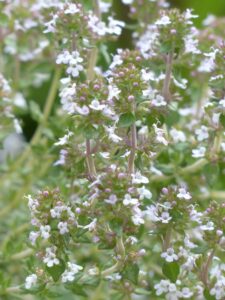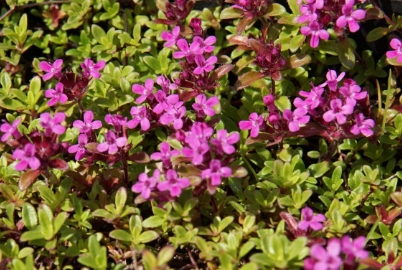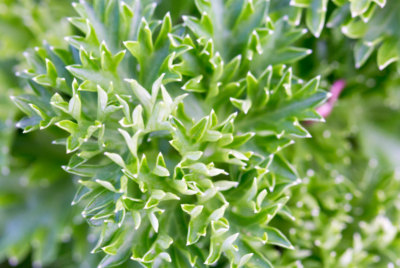Creeping Red Thyme
Creeping Red Thyme
1. Introduction to Creeping Red Thyme
1.1. Importance of Creeping Red Thyme
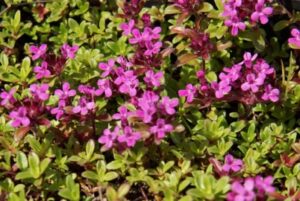
1.2. Overview of its Uses
2. Why Choose Creeping Red Thyme Seeds?

2.1. Aesthetic appeal
2.2. Low maintenance
2.3. in landscaping
3. Different Types of Thyme
3.1. Creeping Red Thyme
3.2. English Thyme
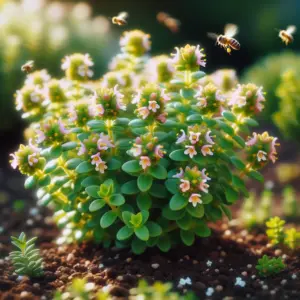
3.3. Lemon Thyme
3.4. Woolly Thyme
3.5. Can Creeping Red Thyme be Used In Cooking?
Creeping red thyme (Thymus serpyllum or similar cultivars) can absolutely be used in cooking! While it’s often grown as a fragrant and visually appealing ground cover, it is edible and has a similar flavor to traditional culinary thyme, though slightly milder.
How to Use Creeping Red Thyme in Cooking
- Flavor Profile: It has a subtle, earthy thyme flavor with floral and herbal notes.
- Culinary Uses:
- Add fresh leaves to soups, stews, and sauces.
- Sprinkle over roasted vegetables, meats, or bread for a fragrant twist.
- Use in marinades, dressings, or infused oils.
- Mix with other herbs in seasoning blends.
- Harvesting: Snip sprigs as needed. For the best flavor, harvest before the plant flowers.
Bonus Benefits
- The edible flowers can be used as garnishes for salads, desserts, or drinks.
- Its compact growth and hardiness make it a dual-purpose plant, beautifying your garden while offering culinary value.
Plant soe in your garden you will fall in love with this delicate herb.
4. Step-by-Step Guide to Planting Creeping Red Thyme Seeds
4.1. Choosing the Right Location
4.2. Preparing the Soil
4.3. Sowing the Seeds
Creeping Red Thyme seeds are tiny, so sowing them requires care. Mix the seeds with sand to ensure even distribution. Scatter the seed-sand mixture over the prepared soil surface lightly, aiming for an even coverage. Do not cover the seeds with soil as they need light to germinate. Instead, gently press them into the soil to ensure contact. Considering their size and light requirement, sowing on a calm day or in a sheltered location can prevent them from being blown away.
4.4. Watering and Care
5. Caring for Your Creeping Red Thyme
5.1. Watering Requirements
5.2. Sunlight Needs
For optimal growth and flowering, Creeping Red Thyme requires full sun exposure, defined as at least six hours of direct sunlight daily. While it can tolerate partial shade, too much shade can result in leggy plants, fewer flowers, and reduced fragrance. In regions with very hot summers, some afternoon shade may be beneficial to prevent scorching. The ideal location is one where the plant can bask in the morning sun and, if necessary, enjoy light shade during the hottest part of the day.
5.3. Soil and Fertilization
Creeping Red Thyme prefers well-drained soil and can even thrive in poor soils where other plants might struggle. It’s not particular about soil pH, adapting well to a range from slightly acidic to alkaline conditions. To improve drainage in heavy clay soils, incorporate organic matter or sand. Fertilization needs are minimal; too much fertilizer can actually harm the plant by encouraging leaf growth at the expense of flowers and fragrance. If you decide to fertilize, opt for a light application of a slow-release, low-nitrogen fertilizer in the spring to support healthy growth without overstimulating the plant.
6. How to Harvest Creeping Red Thyme
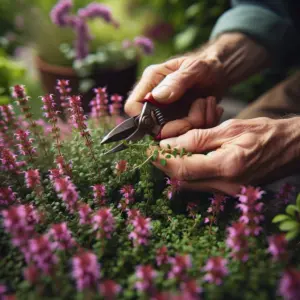
6.1. When to Harvest
The best time to harvest Creeping Red Thyme is just before the plant flowers, typically in late spring to early summer, when the essential oils in the leaves are most concentrated, offering the best flavor and aroma. However, leaves can be harvested as soon as the plant is large enough to provide a sustainable yield without harming its growth. For continual use, small amounts can be picked throughout the growing season. If you aim for a large harvest, timing it right before flowering ensures you capture the plant’s peak potency.
6.2. The Harvesting Process
Harvesting Red Thyme is straightforward and can be done with simple garden scissors or shears. Select healthy, vigorous branches and cut them in the morning after the dew has dried but before the sun is at its strongest, as this is when the plant’s essential oils are most potent. Leave at least a third of the branch on the plant to encourage regrowth; cutting too close to the ground can stress the plant and slow its recovery.
For culinary use, individual leaves can be stripped from the stems or, if the stems are tender, used whole. To dry Creeping Red Thyme, tie cuttings into small bunches and hang them in a warm, airy location out of direct sunlight, or lay them out on a drying rack. Once dried, the leaves can be easily stripped from the stems and stored in an airtight container for future use. Whether fresh or dried, Creeping Red Thyme adds a beautiful aromatic element to dishes and herbal blends.
7. Drying Creeping Red Thyme
7.1. Methods of Drying
Drying Thyme preserves its flavor and aroma for culinary and medicinal uses. There are several effective methods:
a. Air Drying:
This traditional method involves tying small bundles of thyme stems together and hanging them upside down in a warm, dry, well-ventilated area away from direct sunlight. Air circulation is crucial to prevent mold. Depending on the humidity, this process can take 1-2 weeks.
b. Oven Drying:
For a faster method, thyme can be dried in an oven. Lay the sprigs on a baking sheet lined with parchment paper and place them in an oven set to the lowest possible temperature (usually below 200°F or 93°C). Leave the oven door slightly ajar to allow moisture to escape and check regularly to prevent burning. This method can take several hours.
c. Dehydrator:
If you have a dehydrator, it’s an excellent tool for drying thyme. Spread the sprigs on the dehydrator trays and set the temperature to 95-115°F (35-46°C). Drying times can vary, so check periodically until the thyme is completely dry, usually within 8-24 hours.
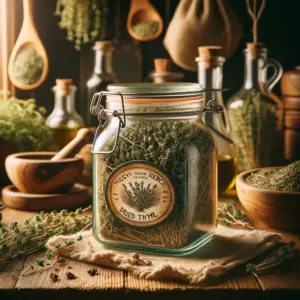
7.2. Storing Dried Thyme
Proper storage is key to maintaining the quality of dried Creeping Red Thyme. Follow these steps for optimal preservation:
a. Conditioning:
Before storage, condition the dried thyme by placing it in airtight containers for a few days. This step allows any residual moisture to distribute evenly. If any condensation forms on the container, further drying is needed.
b. Preparation:
Once fully dried and conditioned, remove the leaves from the stems. The leaves should crumble easily between your fingers.
c. Containers:
Store the dried thyme leaves in airtight containers. Glass jars with tight-fitting lids are ideal, as they protect the thyme from light and moisture. Label each container with the date of drying.
d. Location:
Keep the containers in a cool, dark place, like a pantry or cupboard, away from direct sunlight, moisture, and heat sources.
Properly dried and stored Creeping Red Thyme can retain its flavor and aromatic properties for up to a year, ensuring you have a supply of this versatile herb on hand for a variety of uses.
8. Uses of Creeping Red Thyme
a. Culinary Uses
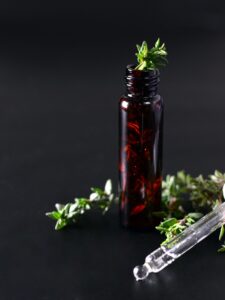
b. Medicinal Benefits
Historically, Creeping Red Thyme has been valued for its medicinal properties, containing thymol, a compound known for its antibacterial and antifungal activities. It has been used in traditional medicine to treat respiratory conditions, such as bronchitis and coughs, by acting as an expectorant to clear mucus from the airways. Creeping Red Thyme can also be used in natural remedies for its antiseptic properties, aiding in the healing of minor cuts and wounds. Herbal teas made from thyme have been employed to soothe sore throats and calm digestive issues, showcasing the plant’s broad therapeutic potential.
Health Benefits of Creeping Red Thyme
-
Rich in Antioxidants
- Contains compounds like thymol and carvacrol that protect cells from oxidative stress.
-
Antimicrobial Properties
- Effective against bacteria, fungi, and some viruses, supporting overall health.
-
Respiratory Support
- Helps alleviate coughs, congestion, and other respiratory issues.
- Acts as a natural expectorant.
-
Digestive Aid
- Stimulates digestion and reduces bloating or gas.
- Has mild carminative properties to ease stomach discomfort.
-
Anti-Inflammatory
- Reduces inflammation, which may help with joint pain and skin irritations.
-
Immune Booster
- Supports immune health due to its antimicrobial and antioxidant properties.
-
Skin Health
- Antibacterial and soothing properties can help with acne or minor wounds.
-
Stress Relief
- The aroma has calming effects that may reduce stress and anxiety.
-
Heart Health
- Contains compounds that may lower blood pressure and improve circulation.
-
Natural Insect Repellent
- Thymol in the plant repels pests, reducing risk of bug-borne diseases.
Creeping Red Thyme Tea
Ingredients:
- 1-2 teaspoons fresh creeping red thyme leaves (or ½ teaspoon dried leaves)
- 1 cup boiling water
- Honey or lemon (optional)
Instructions:
- Harvest fresh thyme and rinse it gently under cool water.
- Place the thyme leaves in a teacup or mug.
- Pour boiling water over the leaves.
- Cover and let steep for 5-7 minutes to extract the flavor and nutrients.
- Strain the tea into another cup if desired.
- Sweeten with honey or add a slice of lemon for extra flavor and health benefits.
Benefits of Drinking Daily:
- Supports digestion and respiratory health.
- Provides a natural immune boost.
- Offers a calming, aromatic moment in your day.
Creeping Red Thyme Infused Oil Recipe
This versatile infused oil is perfect for cooking, salad dressings, or even as a soothing massage oil for skin.
Ingredients:
- 1 cup fresh creeping red thyme (or ½ cup dried thyme)
- 1 cup olive oil (or another carrier oil like avocado or sunflower oil)
Instructions:
- Prepare the Thyme:
- If using fresh thyme, rinse it and pat it completely dry. Moisture can cause the oil to spoil.
- Combine Ingredients:
- Place the thyme in a clean, dry glass jar.
- Pour the oil over the thyme, ensuring it completely covers the herb.
- Infuse the Oil:
- Seal the jar tightly and place it in a warm spot (but out of direct sunlight).
- Let it sit for 2-3 weeks, shaking the jar gently every few days.
- Strain the Oil:
- After infusion, strain the oil through a cheesecloth or fine mesh sieve into a clean bottle.
- Store:
- Keep the infused oil in a cool, dark place. It will last for about 1-2 months.
Uses:
- Drizzle over roasted vegetables, bread, or pasta.
- Massage onto sore muscles or dry skin for its soothing, antibacterial properties.
- Use as a base for homemade salves or skincare products.
Creeping Red Thyme Herbal Seasoning Recipe
This flavorful seasoning blend is perfect for sprinkling on meats, roasted vegetables, soups, or even bread.
Ingredients:
- 2 tablespoons dried creeping red thyme (or 4 tablespoons fresh, finely chopped and dried)
- 1 tablespoon dried rosemary
- 1 tablespoon dried oregano
- 1 tablespoon dried parsley
- 1 teaspoon garlic powder
- 1 teaspoon onion powder
- ½ teaspoon salt (optional)
- ½ teaspoon ground black pepper
Instructions:
- Prepare the Herbs:
- Ensure all herbs are fully dried to prevent clumping. If using fresh thyme, dry it thoroughly before blending.
- Combine Ingredients:
- Mix all ingredients in a bowl until evenly combined.
- Store:
- Transfer the seasoning to an airtight jar or spice container. Store in a cool, dark place for up to 6 months.
Uses:
- Sprinkle on chicken, fish, or vegetables before roasting or grilling.
- Stir into soups, stews, or marinades for a burst of flavor.
- Mix with olive oil for a quick dipping sauce or bread spread.
c. Ornamental Purposes
Beyond its culinary and medicinal uses, Creeping Red Thyme serves an important role in landscaping and garden design for its ornamental value. Its dense mat of foliage, covered with tiny, vibrant flowers, provides an attractive ground cover that can fill spaces between stepping stones, line pathways, or create a colorful, living carpet in rock gardens. The plant’s ability to thrive in challenging conditions, such as poor soil and drought, along with its low maintenance requirements, make it a favorite among gardeners looking to add beauty and resilience to their outdoor spaces. Additionally, its attractiveness to bees and butterflies contributes to pollinator health, enhancing the biodiversity of the garden ecosystem.
9. Troubleshooting Common Issues
9.1. Pest Problems
9.2. Disease Management
Diseases in Creeping Red Thyme are often related to water management and soil conditions. Root rot, caused by excessive moisture and poor drainage, is a common issue. Ensuring well-drained soil and avoiding overwatering are key preventive measures. Fungal diseases, such as powdery mildew, may also affect the plant, manifesting as a white, powdery coating on the leaves. Improving air circulation around the plants and reducing overhead watering can help prevent fungal growth. If diseases occur, removing affected parts and treating the plants with fungicidal sprays or natural alternatives like neem oil can be effective. Maintaining healthy growth conditions and practicing good garden hygiene, such as clearing debris and fallen leaves, are fundamental to preventing pest and disease problems in Creeping Red Thyme.

10. Conclusion
FAQs
1. How often should I water my Creeping Red Thyme?
2. Can Creeping Red be grown indoors?
Yes, with enough light, Creeping Thyme can grow indoors, though it thrives best outdoors.
3. How long does it take for Creeping Red Thyme seeds to germinate?
4. Can Creeping Red Thyme tolerate frost?
5. How do I know when my Creeping Red Thyme is ready to harvest?
